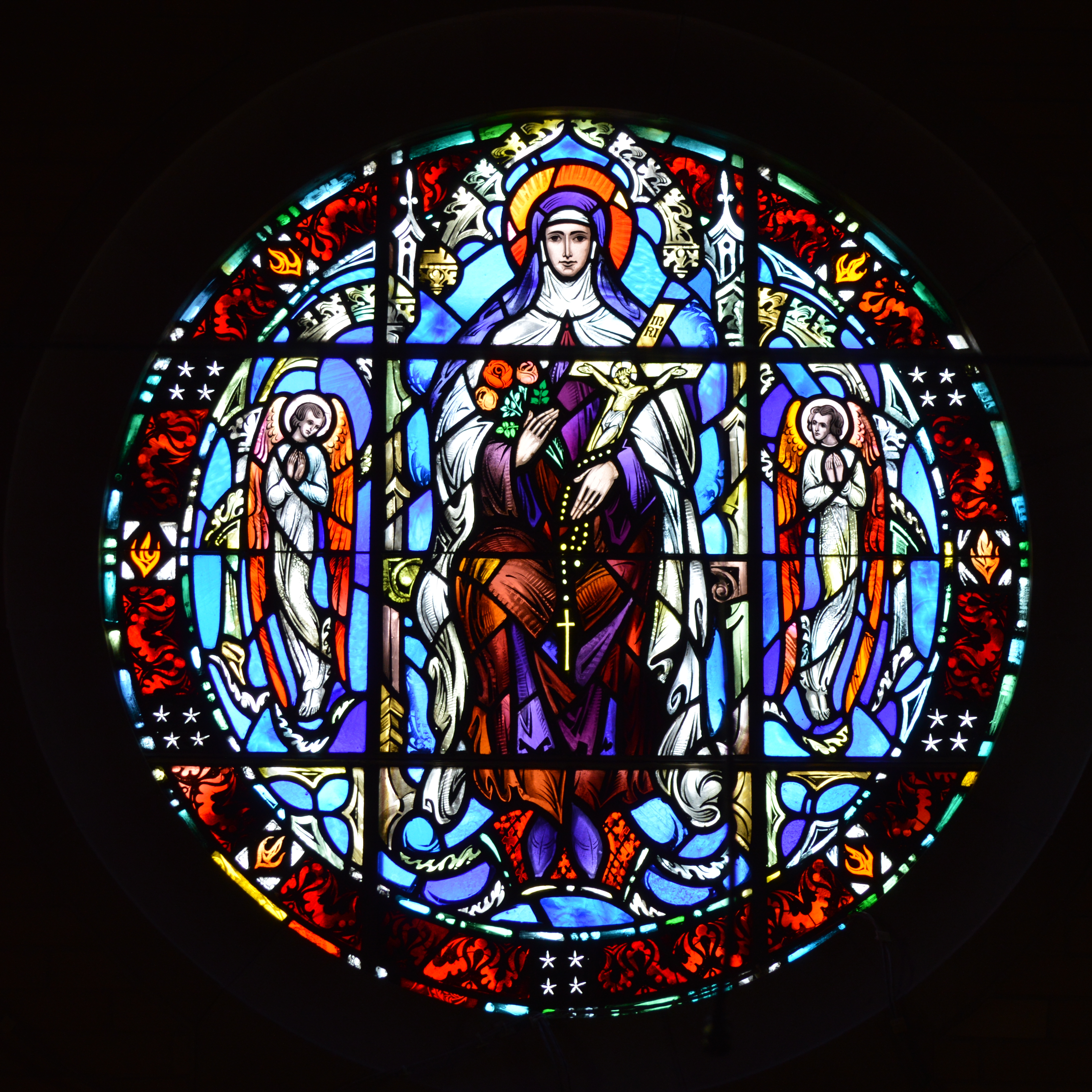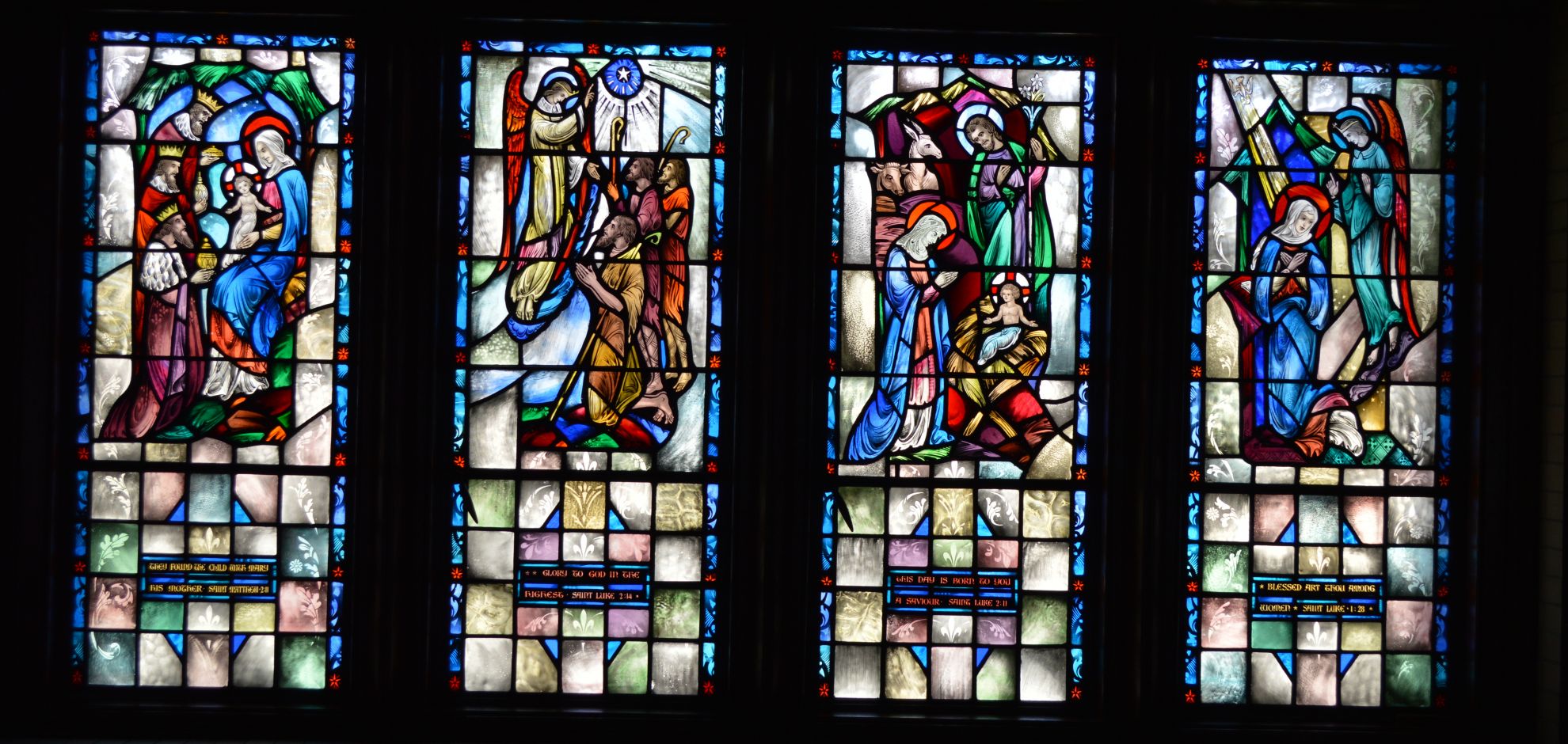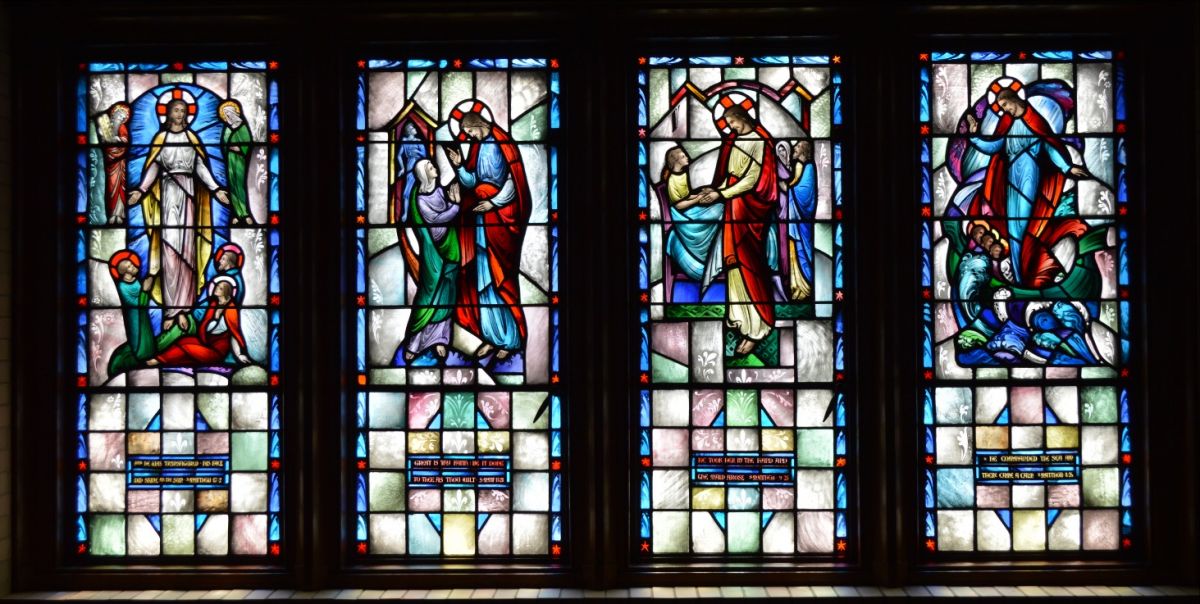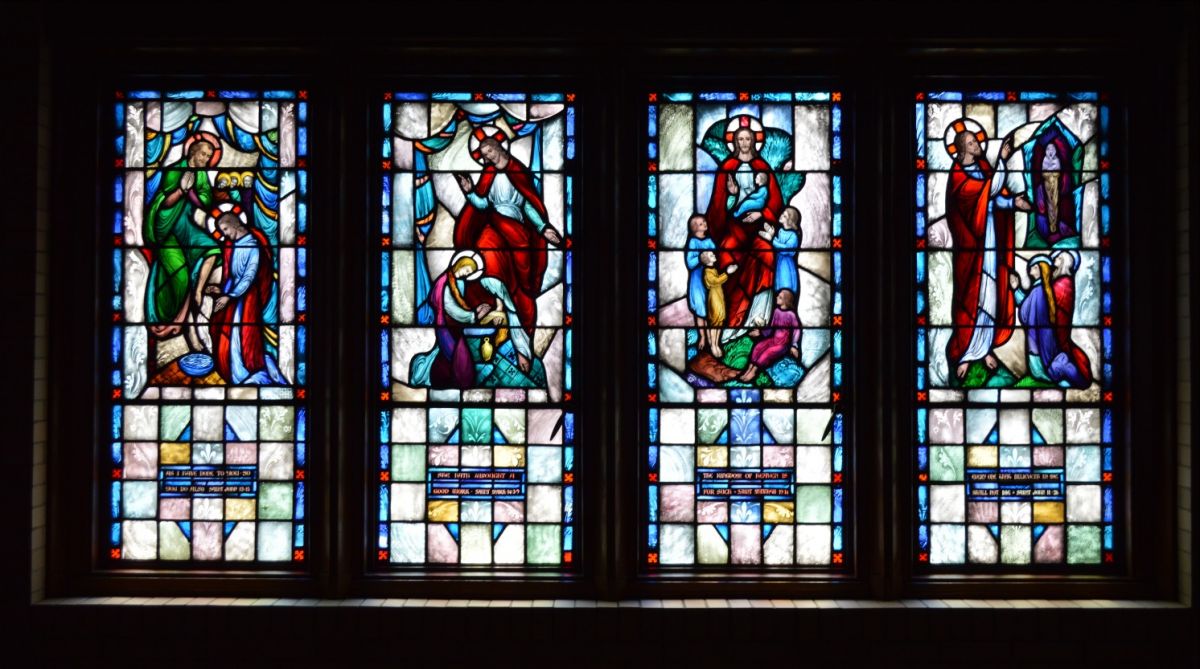A Guide to the
Stained Glass Windows
of Saint Theresa Church
Gift of Honorable and Mrs. Alvan T. Fuller
On Sunday, July 13th, 1958 a dedication Mass held at 11:00 o'clock, to dedicate the Stain Glass Windows. The dedication Mass was presided by the late Bishop Matthew F. Brady, D.D.
The Stain Glass Windows in Saint Theresa Church, where created and produced by Charles J. Connick Associates of Boston. Saint Theresa Church is enriched by two Rose Windows and eleven groups of side windows.
The Supreme Art
“Softly here the quiet light doth fall. From the colored windows above the wall. Gently touching those who kneel to pray. With a faith and hope for peace each day.”
The art of visualizing Biblical themes in stained glass is ages old aiding and strengthening Christian worship both here and abroad. Let us consider the glory of stained glass.
Color has a way of expressing emotional ideas beyond the reach of words. Symbolism is the poets’ way of expressing spiritual ideals. Stained glass finds expression in symbolism.
From the rich spiritual region of the Middle Ages we have inherited a symbolism of color that is still recognized on our workaday world. The red cross of devotion and sacrifice carries its message around stricken world now to remind us that in the 21st century, pure red was the color of Divine Love, of passion and devotion, of self-sacrifice, courage and martyrdom. The Seraphim, nearest to the throne of God, symbols of Divine Love and Adoration, have wings of purest red.
Blue immediately glows before us as the graciously supporting color of red, so we acquiesce with those wise colorists who said that blue is the contemplative color, the color of Divine Wisdom as announced by the blue-winged Cherubim, who joins the Seraphim, around the throne of God. We will also symbolizes eternity, heaven itself, and the steadfastness of enduring loyalty that in our speech today we call true blue.
Green, the color of hope, springtime, youth and victory – Gold, which we characterize in the expression “good as gold”, the medieval masters said symbolizes spiritual treasures, worthy achievement and the good life, while ... Violet, in combination of blue and red, symbolizes justice, mystery, pain and penitence. It forms in some ancient window a beautiful background for shining silvery white, the symbol of faith, of the light of truth, of peace and serenity, - a radiant and significant symbol that is beautifully expressive.

The Rose Window Over the Altar
This Window is a colorful symbol of Christ the king. He is represented enthroned, bearing the scepter, and orb surmounted by the Globe, suggesting His power and dominion over the world.
He is surrounded by a decorative “canopy”, as are the attendant angels at either side.
Nimbed doves accent the border of decorative cloud forms.
This window is kept especially radiant and brilliant, with an abundance of pure white and gold, although passage of rich blue and ruby, insure a colorful quality.

The Rose Window Over the Entrance
This window is devoted to St. Teresa, the Little flower of Jesus, in the robes of the Carmelite Order, with her traditional attributes, the crucifix and red rose. The latter symbolizes her offering to God and calling her promise made just before she died - “After my death I will let fall the shower of roses.”
She is also accompanied by attendant angels, and the border is accented by flames of Divine zeal and stars of heavenly steadfastness.
THE FIRST WINDOW
The nave is illuminated by 11 groups of side Windows, five on the north, and six on the south side, in four panels each, with the exception of the two nearest the entrance which have two panels.
The entire series of forty panels is devoted to the life of Christ represented insignificant and well-known incidents set forth in brilliant sparkling stained glass.
The theme of the Windows developer from the Gospel side (North) nearest the Altar -the usual way of the Cross, and continues around the Epistle Side (South) down to the Altar.
Here are represented His Advent and Infancy; His Childhood and Preparation for His Ministry; the Calling of His Disciples; examples of His power over nature and over death; the teachings of His Parables; His intimate relationship with friends and disciples; His glory and humility; and His final passion, Resurrection and Ascension. They teach through His own example, the way of true Christian life
The subjects are designed in full color, in fields of silvery tones emitted an abundance of elimination and ensuring a brilliant and joyful aspect to the entire fenestration.
The Side Windows

The first group is devoted to the Annunciation (Saint Luke 1:26 – 38); the Nativity (Saint Matthew 1:18-25, Saint Luke 2:1-7); the Angelic Apparition to the Shepherds (Saint Luke 2:8 – 20); and the Epiphany (Saint Matthew 2:1 – 12). Each accompanied by a significant Bible text.
At the right, the Angel of Annunciation approaches the Blessed Virgin Mary as she kneels at her prie-dieu. The Dove of the Holy Spirit sheds its rays of Divine light upon her. The text reads, “Blessed art thou among women” (Saint Luke 1:28).
Again, the Blessed Virgin Mary kneels beside the Christ Child in the manger, while Saint. Joseph with his flowering staff stands nearby. The ox and ass that, according to tradition, bow down at the birth of Our Lord, are seen in the background. Below the text reads, “This day, is born to you a Savior” (Saint Luke 2:11).
In the third panel, the angel announces the glad tidings to the wondering shepherds, while the star of Bethlehem shines above; with the text, “Glory to God in the highest” (Saint Luke 2:14).
Completing the first group, the three Kings present their gifts of gold, frankincense, and myrrh the Holy Child in the arms of His mother, the Blessed Virgin Mary. The text reads, “They found the child with Mary His mother” (Saint Matthew 2:11).
THE SECOND WINDOW

The second group of four windows is devoted to incidents in His childhood: The Presentation in the Temple (Saint Luke 2:22 – 35); The Flight into Egypt (St. Matthew 2:13 – 23); The Boy Christ in the Carpenter shop (St. Matthew 2:23, Saint Luke 2:39, 40, 51, 52); and the Young Christ in the Temple (Saint Luke 2:41 – 50).
The first, at the right, represents the Presentation in the Temple. The Blessed Virgin accompanied by Saint Joseph with the offering of doves, presents the Christ Child to the ancient Simeon. His words appear below – “Behold this child is … for the resurrection of many” (St. Luke 2:34).
The second panel illustrates the Flight into Egypt, with the Blessed Virgin holding the child and writing on the donkey led by St. Joseph. Below is the text, “Joseph…took the child and his mother… into Egypt” (Saint Matthew 2:13 – 14).
The third represents the Holy Family at home at Nazareth. The boy Christ is at work in the Carpenter shop, assisted by Saint Joseph. While the Blessed Virgin reads nearby. The text is, “The Child grew…and the Grace of God was in him" (Saint Luke 2:40).
The fourth symbolizes the Young Christ in the Temple, disputing with the doctors. His Mother is represented returning to find Him. Below is the text, – “all that heard… were astonished at his wisdom” (Saint Luke 2:47)
THE THIRD WINDOW

In the third group is represented the Baptism of Our Lord (Saint Matthew 3:13-17, Saint Mark 1:9-11, Saint Luke 3:21-22); His Temptation (Saint Matthew 4:1-11; Saint Mark 1:12-13; Saint Luke 4:1-13); The First Miracle (Saint John 2:1-11); and the First Cleansing of the Temple (Saint John 2:13-25).
At the right, Saint John the Baptist, in his desert garments of camel’s hair, bearing the rustic cross, stands on the banks of the river Jordan and baptizes Our Lord in the stream. Above Him is the descending Dove of the Holy Spirit, suggesting the words of the text: “This is my beloved Son, in whom I am well pleases (Saint Matthew 3:17).
Next, Our Lord is seated on the mountain, while the devil offers Him the worldly crown. The text: “Man liveth not by bread alone” (Saint Luke 4:4).
In the presence of His blessed Mother and other guest at the Wedding Feast of Cana, Our Lord commands that the waterpots be filled with water, which He turns to wine. The text: “The beginning of Miracles… Manifested his glory” (Saint John 2:11).
Our Lord with the scourge stands in the gate of the temple driving out the trades people and money-changers with their wares; with the prophetic text, “Destroy this temple, and in three days I will Raises it up” (Saint John 2:19).
THE FOURTH WINDOW

The fourth group includes the incident of Christ and the Woman of Samaria at Jacob’s Well (Saint John 4:4-42); the Healing of the Man at the pool of Bethsaida (Saint John 5:2-8); The Calling of the Disciples to be Fishers of Men (saint Matthew 4:18-22; Saint Mark 1:16-20; Saint Luke 5:1-11); and the Call of Saint Matthew (saint Matthew 9:9; Saint Mark 2:13-14; Saint Luke 5:27-28).
Our Lord sits beside the well talking to the woman who has come to draw water, “He that shall drink of the water… I give…Shall not thirst” (Saint John 4:13).
Christ heals the man of his infirmity of thirty-eight years, while the angel who troubled the water is seen above. “Arise, take up thy bed, and walk” (Saint John 5:8).
Again, He stands by the Sea of Galilee beckoning to the fisherman, Simon called Peter and Andrew, his brother, as they cast their nets. “Com ye after me… I will male you… fisher of men” (Saint Matthew 4:19).
And, at the left, He invites Matthew, sitting at the receipt of customs, to follow Him. “He saw… Matthew; and …saith… Follow me” (Saint Matthew 9:9).
The Two Panels Nearest the Entrance

THE FIFTH WINDOW
The two panels nearest the entrance, North Side.
The Two Panels nearest the entrance are devoted to the Sermon on the Mount (Saint Matthew 5:6:7; Saint Luke 6:20-49); and the Healing of the Centurion’s Servant (saint Matthew 8:5-13, Saint Luke 7:1-10).
At the right , Our Lord sits on the Mountain, teaching the Multitude the way of true Christian life “He went up into a mountain, and … taught them” (saint Matthew 5:1-2).
In the companion panel, He reassures the Beseeching Centurion whose servant was grievously tormented. Above, the servant lies sick at home. The text: “As thou hast believed, so be it done unto thee” (Saint Matthew 8:13).

THE SIXTH WINDOW
The two panels nearest the entrance, South Side.
Crossing to the south side, the two balancing windows represents the rising of the Widow’s Son of Naim (Saint Luke 7:11-17); and the Healing of the Blind and Dumb Demoniac (Saint Mathew 12:22-45, Saint Mark 3:22-30, and Saint Luke 11:14-23).
Our Lord takes compassion on the window of Naim, and after touching the bier on which borne her only son, rises him from the dead. “Young man, I say to thee, arise.” (Saint Luke 7:14).
Next, he heals one Possessed with a devil, blind and dumb, while another poor creature kneels in supplication. “He healed him, so that he spoke and saw” (Saint Matthew 12:22).
THE SEVENTH WINDOW

Our Lord’s Miracles are continued in the group of four panels, beginning with Stilling of the Tempest (Saint Matthew 8:23-26; Saint Mark 4:35-40; Saint Luke 8:22-25); The Raising of Jairus’ Daughter (saint Matthew 9:18-26; Saint Mark 5:21-23, Saint Luke 8:41-56); Healing the Daughter of the Syrophenecian Women (Saint Matthew 15:22-28, Saint Mark 7:25-30); and the Transfiguration (Saint Matthew 17:1-13, Saint Mark 9:1-8, Saint Luke 9:28-36).
Having been wakened by his frightened disciples, Or Lord stands in the boat rebuking the Winds and the sea. “He Commanded the … sea, and there came a … calm” (Saint Matthew 8:26).
Next, having come to the ruler’s home, He stands beside the daughter’s bed and restores her to life. “He took her by the hand and the maid arose” (Saint Matthew 9:25).
He rewards the faith of the Syrophenecian Woman, healing her daughter who was grievously troubled by a devil, as seen in the background. “Great is thy faith: be it done to thee as thou wilt” (Saint Matthew 15:28).
Finally, Our Lord stands radiant and transfigured between Moses and Elias above the forms of the three disciples, peter, James, and John. “He was transfigured …. His face did shine as the sun” (Saint Matthew 17:2).
THE EIGHTH WINDOW

The next group is largely devoted to the Parables of Our Lord: The Good Shepherd (Saint John 10:1-17); The Good Samaritan (Saint Luke 10:30-37); Christ at the Home of Martha and Mary (10:38-42); and The Prodigal Son (Saint Luke 15:11-32).
The Good Shepherd tends his flock, carrying a young lamb in his arms. Text: “The good shepherd giveth his life for his sheep” (Saint John 10:11).
The Good Samaritan comes to the aid of the unfortunate man who has fallen among thieves; dressing and binding his wounds. His donkey stands nearby, waiting to carry the injured man to the inn; while the Priest and the Levite pass by above. “A Samaritan… with compassion… took care of him” (Saint Luke 10:33-34).
Out lord received in the home of the sisters, Mary and Martha or Bethany. Mary sits attentively at His feet, while Martha is busy with the household duties. “Mary… Sitting … at the Lord’s feet, heard his word” (Saint Luke 10:39).
Completing the group, the father of the returned prodigal has compassion on him, welcoming him after his experienced in riotous living and famine. The text: “My son was dead and is come to life again” (Saint Luke 15:24).
THE NINTH WINDOW

In the Next group is the Raising of Lazarus (Saint John 11:1-44); Christ Blessing the Little Children (Saint Matthew 19:13-14, Saint Mark 10:13-16, Saint Luke 18:15-17); The Anointing by Mary (Saint Matthew 26:6-13, Saint Mark 14:3-9, Saint John 12:2-8); and Christ Washing the feet of His Disciples (Saint John 13:1-13)
Our Lord calls forth Lazarus from the tomb, bound feet and hands with winding bands. Lazarus’ sisters and Christ’s friends, Martha and Mary, kneel before Him. Text: “Every one that…believth in me shall not die” (Saint John 11:26).
Our Lord shows His love and compassion for the little children in blessing those who were brought unto Him. He holds a small child in His arms, while other are grouped around Him. Text: “The Kingdom of Heaven is for such” (Saint Matthew 19:14).
Mary shows her devotion to Our Lord by anointing His feet with the costly ointment, wiping them with her hair. Text: “She hath wrought a good work” (Saint Mark 14:6).
Next, Our Lord shows His humility and love by washing the feet of His Disciples, including Saint Peter. Text: “As I have done to you, so you do also” (Saint John13:15).
THE TENTH WINDOW

The next group symbolizes the Last Supper (Saint Matthew 26:26-29, Saint Mark 14:22-25, Saint Luke 22:19-20, 1Corinthians 11:23-25); the Agony in the Garden of Gethsemani (Saint Matthew 26:36-44, Saint Mark 14:32-42, Saint Luke 22:39-46); Christ before Pilate (Saint Matthew 27:11-14, Saint Mark 15:1-5, Saint Luke 23:1-4, Saint John 18:28-38); and the Scourging (Saint Matthew 27:26-30, Saint Mark 15:15-19).
Christ site at the head of the table, holding the chalice in one hand, and the other in the attitude of blessing, with the twelve apostles grouped around Him. “Do this for commemoration of me” (Saint Luke 22:19).
After supper, He goes with His apostles to the Garden called Gethsemani, and retires to pray, while His Disciples sleep. Text: “Father … not my will, but thine be done” (Saint Luke 22:42).
Next, He stands before Pilate. “Pilate … saith to the Jews: Behold your king” (Saint John 19:13-14).
After being condemned, He is mocked, scourged, and robed with a scarlet cloak. “Pilate took Jesus, and scourged him” (Saint John 19:1).
THE ELEVENTH WINDOW

The Last group is devoted to His death and final triumph, with the Crucifixion (Saint Matthew 27:31-38, Saint Mark 15:20-28, Saint Luke 23:26-46, Saint John 19:16-37); The Resurrection (Saint Matthew 28:1-8, Saint Mark 16:1-38, Saint Luke 24:1-7, Saint John 20:1-13); At Supper with His Companions at Emmaus (Saint Mark 16:12-13, Saint Luke 24:13-35); and The Ascension (Acts 1:9-11, Saint Mark 16:19, Saint Luke 24:51).
In the first panel, Christ is represented on the Cross between the figures of His Blessed Mother Mary and the beloved Disciple, Saint John. The text is taken from His words on the Cross, - “Father, forgive them, for they know not what they do” (Saint Luke 23:34).
Next, the risen Christ comes forth from the dark tomb, bearing the cruciform banner of victory. At either side are the sleeping guards. “Fear not… tell my brethren that … they shall see me” (Saint Matthew 28:10).
In the third panel, Christ is represented at Supper at the moment of His recognition by the two friends He had met on the road to Emmaus. “He took bread…and gave to them… they knew him” (Saint Luke 24:30-31).
The final panel is devoted to the Ascension of our Lord. His radiant figure is surrounded by the apostles and the Blessed Virgin, “Whilst he blessed them, he … was carried up to heaven” (Saint Luke 24:51).
